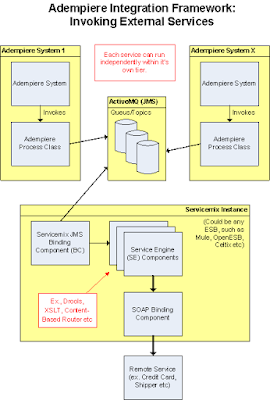External services can be any system that Adempiere needs to communicate with. For example, integrating with a shipper or credit card processor comes to mind. Or, synchronizing data with popular CRM systems such as Salesforce.com or SugarCRM. While people have been doing this sort of thing with Compiere/Adempiere for a long time, more often than not, it's a point-to-point integration. The disadvantage to this approach is that it can quickly become unmanageable, and tightly couples the integration code into Adempiere. This limits flexibility, and can be fragile and difficult to maintain.
The increasing popularity of Enterprise Service Buses (ESB) has occurred because of the recognized limitations and issues surrounding point-to-point integrations. In addition, ESB's generally provide a bevy of reusable adapters, such as SOAP, HTTP, Email, FTP etc., that eliminate the need to recode these solutions over-and-over again. Often, they also have sophisticated business process orchestration features such as BPEL, built-in, to help design and manage complex workflows. Popular open-source ESB's include Mule, Apache Servicemix, OpenESB , PetalsESB and Celtix.
In the scenario for today's topic I want to discuss a framework that can be use invoking external services from within Adempiere using a Process. The Process, in turn, publishes the outbound request into a JMS queue or topic. From there, it is lifted for processing by an ESB. The ESB, using it's rich set of pre-built adapters, transforms the request to the destination format, and submits it for processing. This process can be asynchronous or synchronous, depending up the client's requirements.
Why not just invoke the ESB directly from within the Adempiere Process. Again, it's about keeping things loosely coupled. We might want to change ESB's at some future point, and hardwiring specific ESB code (most likely proprietary in nature, using it's APIs) into the Adempiere Process callout limits such flexibility.
Using JMS, however, we can define a standard XML schema for the data transfer. As long as the request/response adheres to the proper format, the Adempiere Process could really care less about the implementation details.
Below is a diagram of what I'm describing:

As you can see, in this diagram, I'm using the Servicemix ESB (which I do have a preference for, given it's JBI-compliance, maturity, breadth, and Spring-based architecture). A Servicemix JMS component (in JBI parlance, that's a "Binding Component") lifts the JMS message sent by the Adempiere Process, then performs some transformation and business rule processing using pre-built components designed for that purpose ("Service Engines", in JBI). Then, when the XML is in the appropriate format/schema, a SOAP adapter is used to call the external web service that's providing the service desired.
This architecture is highly flexible, and allows for a wide variety of implementations. For example, the JMS and Servicemix instances can be running in a distributed fashion on one more services (both ActiveMQ and Servicemix provide clustering capabilities as well).
In my next article, I'll describe how an ESB can be used to receive inbound request generated externally from Adempiere. For example, a sales order that is received from an external channel, such as an ecommerce web site.
As always, I welcome your thoughts/comments.
jeff
Add to Technorati Favorites
Add to Digg
10 comments:
Hi Jeff,
very good article.
Thank you!!!
I'm wating for next article with example :)
Kind regards,
Trifon
Hi Jeff Davis,
You are sitting on an iceberg. This looks like the beginning of a big picture.
Way to go buddy!
red1
Good stuff. I was also thinking of how to start a SOA in adempiere. You have now cleared the bush.
I am waiting for part 2 of the article with sample code.
I was researching using Mule ESB. I will try Service Mix ESB and see how it works.
Hi Jeff,
thanks for your article, it's very interesting.
However I still have questions: :-)
- Does it work for compiere as well!? Do you know any ressources that gives indications about this question?!
- Do you (or anybody) know were we could find examples of code!? Even for point-to-point integration...
Thanks a lot.
Exactly dear you can use it with compiere. Compiere support it fully like Adempiere.
good bye..
Excellent article. I'm looking forward to the next article!
Many thanks,
Chris
Post a Comment